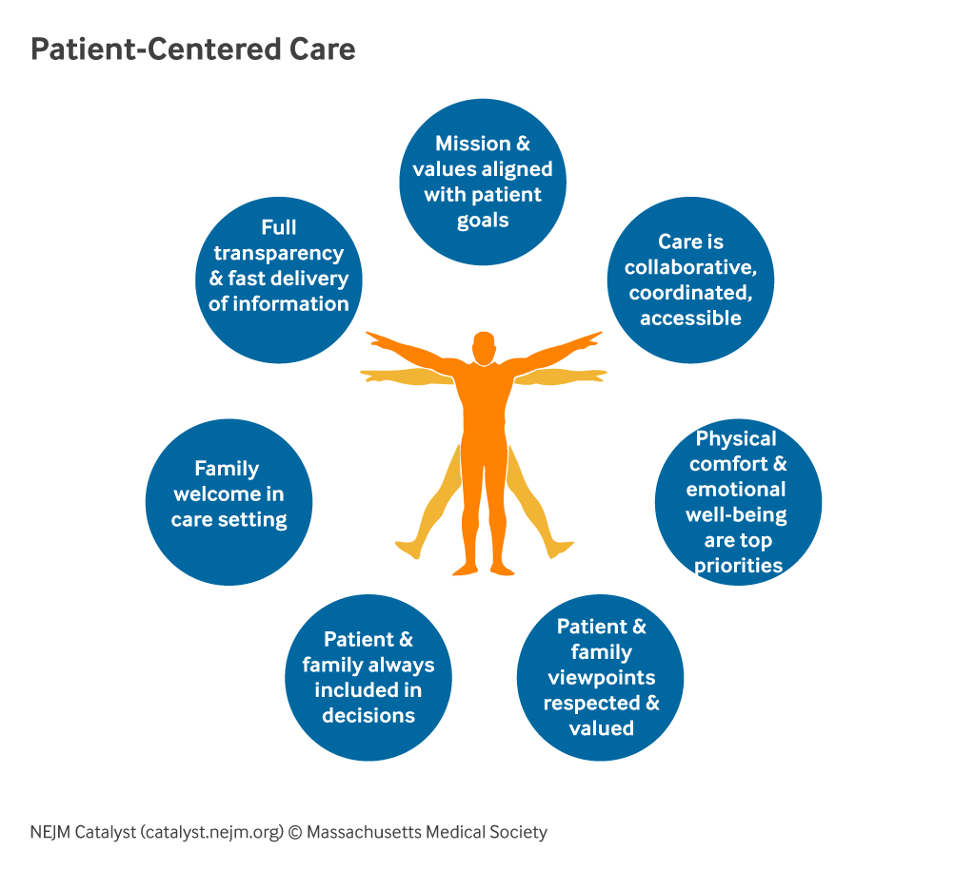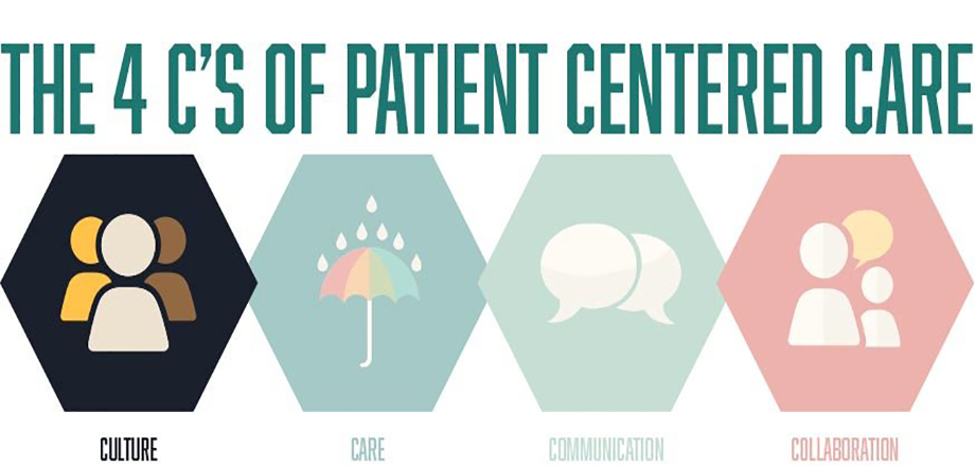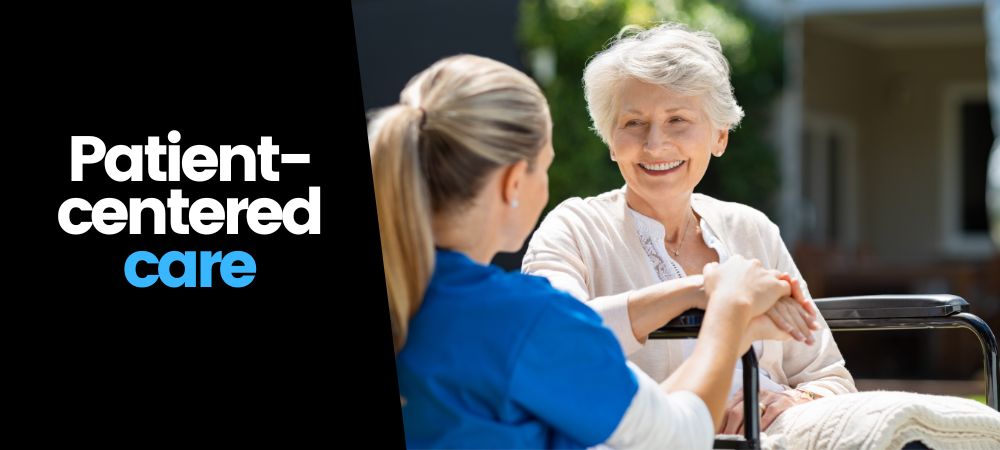Let’s play Jeopardy—briefly. The contestant chooses healthcare for $1000.
The host reads the answer…
Providing care that is respectful of, and responsive to, individual patient preferences, needs, and values, and ensuring that patient values guide all clinical decisions.
Ding! The contestant answers…
What is patient-centered care?
Correct. (The definition comes from the Institute of Medicine).
Okay, TVs off, please. It’s time to read.
Beyond critical treatment
NEJM Catalyst reiterates what we learned from our quick visit to the long-running gameshow…
“In patient-centered care, an individual’s specific health needs and desired health outcomes are the driving force behind all health care decisions and quality measurements.”
They add this important idea:
“Patients are partners with their health care providers, and providers treat patients not only from a clinical perspective, but also from an emotional, mental, spiritual, social, and financial perspective.”
Success depends on a partnership between individuals and their healthcare providers. The individual’s needs and aspirations drive both healthcare decisions and how outcomes are measured.
The objective of patient-centered healthcare is to make patients more engaged, and therefore, more satisfied with the delivery of their care. And the hope is efficacy increases.
7 elements of patient-centered healthcare
We’ll stick with NEJM Catalyst here to examine the benefits of patient-centered care.

Starting at 12 o’clock in the image above, seven elements are revealed:
- The health care system’s mission, vision, values, leadership, and quality-improvement drivers are aligned to the patient’s goals.
- Care is collaborative, coordinated, and accessible.
- Care focuses on physical comfort as well as emotional well-being.
- The patient’s and family’s preferences, values, and socioeconomic conditions are respected.
- Patients and their families play a role in decisions at the patient and system level.
- The presence of family members in the care setting is encouraged and facilitated.
- Information is shared in a timely manner so patients and their family members are empowered to make informed decisions.

HealthLeads attempts to simplify patient-centered care with four C’s: culture, care, communication, and collaboration.
The benefits of patient-centeredness
According to Welkin Health, four evidence-based benefits of patient-centered healthcare serve patients and providers alike.
1. Improved outcomes
Research from AMA Journal of Ethics claims that when patient values and preferences are prioritized, they engage more in treatments, which results in better health outcomes. Practices are able to:
- Lower ER visit rates
- Accelerate recovery times
- Decrease utilization of healthcare resources
- Increase patient, family, and care team satisfaction
- Improved health outcomes.
2. Improved patient satisfaction
Patient-centered care increases patient satisfaction. The patient’s active participation drives the care plan and gives clinicians a clearer idea of how to exceed their expectations.
3. Improved reputation for your organization
Obviously, you can no longer ignore your practice’s reputation as shared via online media channels. With patient-centered care models, more patients feel they’re being taken care of properly and more safely.
4. Higher staff satisfaction
Patient-centered care has proven to increase staff morale and job satisfaction. When clinicians feel they work at a healthcare organization focused on patient-specific needs, they are more likely to feel satisfied with and less likely to feel burnout.
7 essential patient-centered care best practices
1. Ensure accessibility
Offer appointment options that are easy to schedule. Also, ensure the referrals you provide to accessible specialists are clear. Finally, be sure patients that can’t travel to your location are informed about available transportation options.
2. Respect your patients’ needs and preferences
Understand the evolving integrative health care landscape your patients live in. Consider botanical medicine remedies, pain management options, and any religious or cultural values patients have.
3. Coordinate care
Actively participate in and understand your patient’s care plan. Be flexible when coordinating front-line patient care, clinical care, ancillary care, and support services. Ensure every clinician remains informed about each step in the patient’s care.
4. Inform your patients
Help your patients feel in control of their care. Motivate them to follow the care plan by respecting their need for information. Provide thorough information regarding their clinical status, progress and prognosis, care processes, and autonomous self-care.
5. Provide emotional and physical comfort
When patients are physically comfortable and calm, they’re likely to be more willing to discuss their pain management options their assistance needs. Do what you can to reduce anxiety and ensure patients you have their best interests at heart. Address any anxieties they express regarding their status, prognosis, or treatment.
6. Involve family and friends
It’s vital to accommodate the family and close friends your patients trust and involve them in the decision-making. Explain your care plan to them so they can participate—and help. Let caregivers know you recognize their needs and will act as a trusted consultant and supporter.
7. Ensure continuity of care
Patient-centered care doesn’t end when the patient goes home. Make sure the patient’s family and caretakers understand the patient’s physical limitations, dietary requirements, and medication schedules. Ensure they’re informed about access to physical, financial, clinical, and social resources related to the treatment plan.
CRM is the information center for patient-centered care
“We’re seeing a huge appetite from patients to interact with us digitally and connect with care. We’ve shifted the paradigm from reactive — answering when a patient calls us — to proactive and engaging patients when we can see that they need care. We’re developing a unified strategy to orchestrate the patient’s journey across a lifetime of care and thousands of patients are already seeing the impact.”
Lisa Yerian, MD, Chief Improvement Officer at Cleveland Clinic
How is Cleveland Clinic executing in its effort to accomplish what Dr. Yerian said?
In short, the answer is by integrating its EHR system with CRM.
“As Epic is our clinical record of truth, the CRM system is our engagement record of truth. Anytime you can think of consistent engagement, that’s where you can see the CRM system coming into play,” says Beth Meese, Executive Director of Digital Health & Enterprise CRM at Cleveland Clinic.
You’ll want to learn more about the role HIPAA-compliant CRM plays in delivering a new patient-centric approach to healthcare, but above all, understand:
CRM represents a centralized and automated way to gather and track patient engagement data. Every caregiver can access the information needed to create the highest quality, most personalized, and compassionate experience for the patient.







